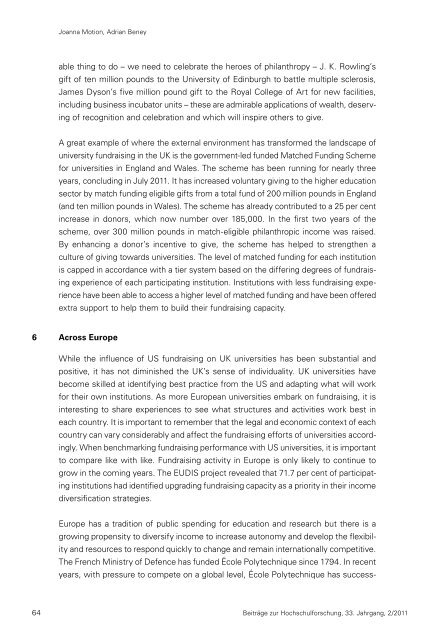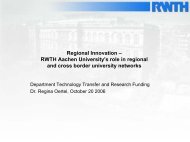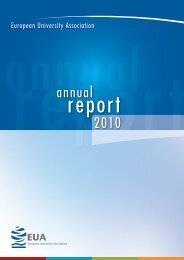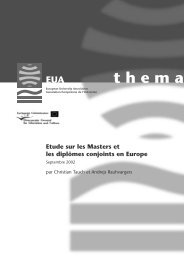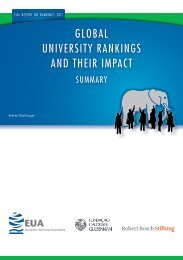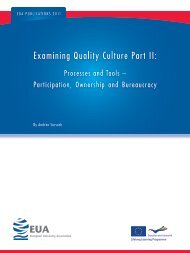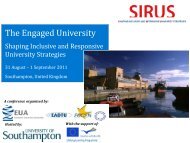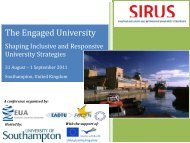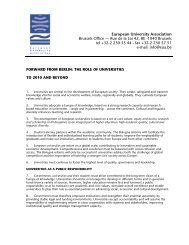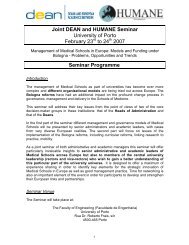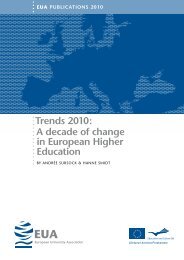Beiträge zur Hochschulforschung - European University Association
Beiträge zur Hochschulforschung - European University Association
Beiträge zur Hochschulforschung - European University Association
Create successful ePaper yourself
Turn your PDF publications into a flip-book with our unique Google optimized e-Paper software.
64<br />
Joanna Motion, Adrian Beney<br />
able thing to do – we need to celebrate the heroes of philanthropy – J. K. Rowling’s<br />
gift of ten million pounds to the <strong>University</strong> of Edinburgh to battle multiple sclerosis,<br />
James Dyson’s five million pound gift to the Royal College of Art for new facilities,<br />
including business incubator units – these are admirable applications of wealth, deserv-<br />
ing of recognition and celebration and which will inspire others to give.<br />
A great example of where the external environment has transformed the landscape of<br />
university fundraising in the UK is the government-led funded Matched Funding Scheme<br />
for universities in England and Wales. The scheme has been running for nearly three<br />
years, concluding in July 2011. It has increased voluntary giving to the higher education<br />
sector by match funding eligible gifts from a total fund of 200 million pounds in England<br />
(and ten million pounds in Wales). The scheme has already contributed to a 25 per cent<br />
increase in donors, which now number over 185,000. In the first two years of the<br />
scheme, over 300 million pounds in match-eligible philanthropic income was raised.<br />
By enhancing a donor’s incentive to give, the scheme has helped to strengthen a<br />
culture of giving towards universities. The level of matched funding for each institution<br />
is capped in accordance with a tier system based on the differing degrees of fundrais-<br />
ing experience of each participating institution. Institutions with less fundraising expe-<br />
rience have been able to access a higher level of matched funding and have been offered<br />
extra support to help them to build their fundraising capacity.<br />
6 Across Europe<br />
While the influence of US fundraising on UK universities has been substantial and<br />
positive, it has not diminished the UK’s sense of individuality. UK universities have<br />
become skilled at identifying best practice from the US and adapting what will work<br />
for their own institutions. As more <strong>European</strong> universities embark on fundraising, it is<br />
interesting to share experiences to see what structures and activities work best in<br />
each country. It is important to remember that the legal and economic context of each<br />
country can vary considerably and affect the fundraising efforts of universities accord-<br />
ingly. When benchmarking fundraising performance with US universities, it is important<br />
to compare like with like. Fundraising activity in Europe is only likely to continue to<br />
grow in the coming years. The EUDIS project revealed that 71.7 per cent of participat-<br />
ing institutions had identified upgrading fundraising capacity as a priority in their income<br />
diversification strategies.<br />
Europe has a tradition of public spending for education and research but there is a<br />
growing propensity to diversify income to increase autonomy and develop the flexibil-<br />
ity and resources to respond quickly to change and remain internationally competitive.<br />
The French Ministry of Defence has funded École Polytechnique since 1794. In recent<br />
years, with pressure to compete on a global level, École Polytechnique has success-<br />
<strong>Beiträge</strong> <strong>zur</strong> <strong>Hochschulforschung</strong>, 33. Jahrgang, 2/2011


